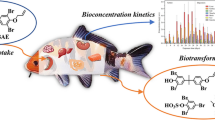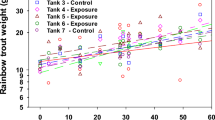Abstract
Decabromodiphenyl ether (BDE209) is poorly absorbed by mammals, and little information is available on the toxicokinetics of BDE209 and its metabolites in fish. In the present study, rainbow trout (Oncorhynchus mykiss) were administered to 100 ng/g and 500 ng/g body wet weight of BDE209 via a single intraperitoneal injection and parent BDE209 and its metabolites were sequentially monitored for 28 days. The results showed that toxicokinetic profiles of BDE209 could be described by the one-compartment model. In the higher dose group (500 ng/g wet weight), the calculated half-life (t 1/2) and elimination rate (k e) were 17.7 d and 0.039/d in the liver, and 100.3 d and 0.007/d in the muscle, respectively. Three major methoxylated brominated diphenyl ethers (MeO-BDEs) were detected with 2,2′,4,4′-tetrabromo-5-methoxydiphenyl ether (5-MeO-BDE47) being detected in all tissue samples. There was no significant temporal change of 5-MeO-BDE47 concentration in the muscle, whereas an exponential increase was observed in the liver. Therefore, the metabolism rate of BDE209 depended on the administered dose. BDE209 was hardly accumulated in the muscle of rainbow trout, while the liver was a primary metabolic organ. MeO-BDEs were formed via metabolism of BDE209, which probably played a significant role in fish toxicology as a potential indicator.
Similar content being viewed by others
References
Gao Z, Xu J, Xian Q, Feng J, Chen X, Yu H. Polybrominated diphenyl ethers (PBDEs) in aquatic biota from the lower reach of the Yangtze River, East China. Chemosphere, 2009, 75: 1273–1279
Hallgren S, Darnerud P. Polybrominated diphenyl ethers (PBDEs), polychlorinated biphenyls (PCBs) and chlorinated paraffins (CPs) in rats-testing interactions and mechanisms for thyroid hormone effects. Toxicology, 2002, 177: 227–243
Siddiqi M, Laessig R, Reed K. Polybrominated diphenyl ethers (PBDEs): New pollutants-old diseases. Clin Med Res, 2003, 1: 281–290
Tseng L, Lee C, Pan M, Tsai S, Li M, Chen J, Lay J, Hsu P. Postnatal exposure of the male mouse to 2,2′,3,3′,4,4′,5,5′,6,6′-decabrominated diphenyl ether: Decreased epididymal sperm functions without alterations in DNA content and histology in testis. Toxicology, 2006, 224: 33–43
Stockholm Convention on Persistent Organic Pollutants (POPs), 2009
de Wit C. An overview of brominated flame retardants in the environment. Chemosphere, 2002, 46: 583–624
Strandberg B, Dodder N, Basu I, Hites R. Concentrations and spatial variations of polybrominated diphenyl ethers and other organohalogen compounds in Great Lakes air. Environ Sci Technol, 2001, 35: 1078–1083
Stapleton H, Dodder N, Offenberg J, Schantz M, Wise S. Polybrominated diphenyl ethers in house dust and clothes dryer lint. Environ Sci Technol, 2005, 39: 925–931
Chen S, Gao X, Mai B, Chen Z, Luo X, Sheng G, Fu J, Zeng E. Polybrominated diphenyl ethers in surface sediments of the Yangtze River Delta: Levels, distribution and potential hydrodynamic influence. Environ Pollut, 2006, 144: 951–957
Guo Y, Meng X, Tang H, Mai B, Zeng E. Distribution of polybrominated diphenyl ethers in fish tissues from the Pearl River Delta, China: Levels, compositions, and potential sources. Environ Toxicol Chem, 2008, 27: 576–582
Hites R. Polybrominated diphenyl ethers in the environment and in people: a meta-analysis of concentrations. Environ Sci Technol, 2004, 38: 945–956
Wu N, Herrmann T, Paepke O, Tickner J, Hale R, Harvey E, La Guardia M, McClean M, Webster T. Human exposure to PBDEs: Associations of PBDE body burdens with food consumption and house dust concentrations. Environ Sci Technol, 2007, 41: 1584–1589
Lepom P, Karasyova T, Sawal G. Occurrence of polybrominated diphenyl ethers in freshwater fish from Germany. Organohalogen compd, 2002, 58: 209–212
Hakk H, Larsen G, Klasson-Wehler E. Tissue disposition, excretion and metabolism of 2,2′,4,4′,5-pentabromodiphenyl ether (BDE-99) in the male Sprague-Dawley rat. Xenobiotica, 2002, 32: 369–382
Stoker T, Cooper R, Lambright C, Wilson V, Furr J, Gray L. In vivo and in vitro anti-androgenic effects of DE-71, a commercial polybrominated diphenyl ether (PBDE) mixture. Toxicol Appl Pharmacol, 2005, 207: 78–88
Staskal D, Hakk H, Bauer D, Diliberto J, Birnbaum L. Toxicokinetics of polybrominated diphenyl ether congeners 47, 99, 100, and 153 in mice. Toxicol Sci, 2006, 94(1): 28–37
Van der Ven LTM, Van de Kuil T, Leonards PEG, Slob W, Cantón RF, Germer S, Visser TJ, Litens S, Håknsson H, Schrenk D, Van den Berg M, Piersma AH, Vos JG, Opperhuizen AA. 28-day oral dose toxicity study in Wistar rats enhanced to detect endocrine effects of decabromodiphenyl ether (decaBDE). Toxicol Lett, 2008, 179: 6–14
Eriksson J, Green N, Marsh G, Bergman A. Photochemical decomposition of 15 polybrominated diphenyl ether congeners in methanol/water. Environ Sci Technol, 2004, 38: 3119–3125
Soderstrom G, Sellstrom U, de Wit C, Tysklind M. Photolytic debromination of decabromodiphenyl ether (BDE 209). Environ Sci Technol, 2004, 38: 127–132
Gerecke A, Hartmann P, Heeb N, Kohler H, Giger W, Schmid P, Zennegg M, Kohler M. Anaerobic degradation of decabromodiphenyl ether. Environ Sci Technol, 2005, 39: 1078–1083
Van den Steen E, Covaci A, Jaspers V, Dauwe T, Voorspoels S, Eens M, Pinxten R. Accumulation, tissue-specific distribution and debromination of decabromodiphenyl ether (BDE 209) in European starlings (Sturnus vulgaris). Environ Pollut, 2007, 148: 648–653
Stapleton H, Brazil B, Holbrook R, Mitchelmore C, Benedict R, Konstantinov A, Potter D. In vivo and in vitro debromination of decabromodiphenyl ether (BDE209) by juvenile rainbow trout and common carp. Environ Sci Technol, 2006, 40: 4653–4658
Kierkegaard A, Balk L, Tjarnlund U, de Wit C, Jansson B. Dietary uptake and biological effects of decabromodiphenyl ether in rainbow trout (Oncorhynchus mykiss). Environ Sci Technol, 1999, 33: 1612–1617
Stapleton H, Alaee M, Letcher R, Baker J. Debromination of the flame retardant decabromodiphenyl ether by juvenile carp (Cyprinus carpio) following dietary exposure. Environ Sci Technol, 2004, 38: 112–119
Hardy ML. The toxicology of the three commercial polybrominated diphenyl oxide (ether) flame retardants. Chemosphere, 2002, 46: 757–777
Vetter W, Stoll E, Garson M, Fahey S, Gaus C, Müller J. Sponge halogenated natural products found at parts-per-million levels in marine mammals. Environ Toxicol Chem, 2002, 21: 2014–2019
Mörck A, Hakk H, Örn U, Wehler E. Decabromodiphenyl ether in the rat: absorption, distribution, metabolism, and excretion. Drug Metab Dispos, 2003, 31: 900–907
Vetter W, Jun W. Non-polar halogenated natural products bioaccumulated in marine samples. II. Brominated and mixed halogenated compounds. Chemosphere, 2003, 52: 423–431
Teuten E, Xu L, Reddy C. Two abundant bioaccumulated halogenated compounds are natural products. Science, 2005, 307: 917–920
Luo Q, Wong M, Cai Z. Determination of polybrominated diphenyl ethers in freshwater fishes from a river polluted by e-wastes. Talanta, 2007, 72: 1644–1649
Eljarrat E, Labandeira A, Marsh G, Raldúa D, Barceló D. Decabrominated diphenyl ether in river fish and sediment samples collected downstream an industrial park. Chemosphere, 2007, 69: 1278–1286
Muirhead E, Skillman A, Hook S, Schultz I. Oral exposure of PBDE-47 in fish: toxicokinetics and reproductive effects in Japanese medaka (Oryzias latipes) and fathead minnows (Pimephales promelas). Environ Sci Technol, 2006, 40: 523–528
Tomy G, Tittlemier S, Palace V, Budakowski W, Braekevelt E, Brinkworth L, Friesen K. Biotransformation of N-ethyl perfluorooctanesulfonamide by rainbow trout (Onchorhynchus mykiss) liver microsomes. Environ Sci Technol, 2004, 38: 758–762
McKinney MA, De Guise S, Martineau D, Beland P, Arukwe A, Letcher RJ. Biotransformation of polybrominated diphenyl ethers and polychlorinated biphenyls in beluga whale (Delphinapterus leucas) and rat mammalian model using an in vitro hepatic microsomal assay. Aquat Toxicol, 2006, 77: 87–97
Sandholm A, Emanuelsson BM, Wehler EK. Bioavailability and half-life of decabromodiphenyl ether (BDE-209) in rat. Xenobiotica, 2003, 33: 1149–1158
Thomas GO, Moss SEW, Asplund L, Hall AJ. Absorption of decabromodiphenyl ether and other organohalogen chemicals by grey seals (Halichoerus grypus). Environ Pollut, 2005, 133: 581–586
Thuresson K, Höglund P, Hagmar L, Sjödin A, Bergman Å, Jakobsson K. Apparent half-lives of hepta- to decabrominated diphenyl ethers in human serum as determined in occupationally exposed workers. Environ Health Persp, 2006, 114: 176–181
Tomy G, Palace V, Halldorson T, Braekevelt E, Danell R, Wautier K, Evans B, Brinkworth L, Fisk A. Bioaccumulation, biotransformation, and biochemical effects of brominated diphenyl ethers in juvenile lake trout (Salvelinus namaycush). Environ Sci Technol, 2004, 38: 1496–1504
Montory M, Barra R. Preliminary data on polybrominated diphenyl ethers (PBDEs) in farmed fish tissues (Salmo salar) and fish feed in Southern Chile. Chemosphere, 2006, 63: 1252–1260
Verreault J, Gabrielsen G, Chu S, Muir D, Andersen M, Hamaed A, Letchers R. Flame retardants and methoxylated and hydroxylated polybrominated diphenyl ethers in two Norwegian Arctic top predators: Glaucous gulls and polar bears. Environ Sci Technol, 2005, 39: 6021–6028
Kierkegaard A, Bignert A, Sellstrm U, Olsson, M, Asplund L, Jansson B, de Wit C. Polybrominated diphenyl ethers (PBDEs) and their methoxylated derivatives in pike from Swedish waters with emphasis on temporal trends, 1967–2000. Environ Pollut, 2004, 130: 187–198
Valters K, Li H, Alaee M, D’sa I, Marsh G, Bergman A, Letcher R. Polybrominated diphenyl ethers and hydroxylated and methoxylated brominated and chlorinated analogues in the plasma of fish from the Detroit River. Environ Sci Technol, 2005, 39: 5612–5619
Author information
Authors and Affiliations
Corresponding author
Rights and permissions
About this article
Cite this article
Feng, C., Xu, Y., Zha, J. et al. Toxicokinetics and the related metabolites in rainbow trout (Oncorhynchus mykiss) after exposure to decabromodiphenyl ether. Sci. China Chem. 53, 2379–2386 (2010). https://doi.org/10.1007/s11426-010-4020-1
Received:
Accepted:
Published:
Issue Date:
DOI: https://doi.org/10.1007/s11426-010-4020-1




